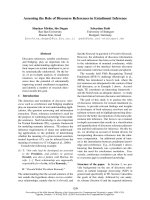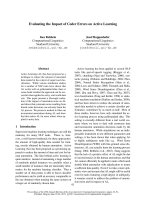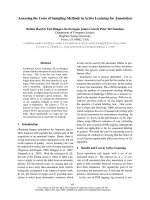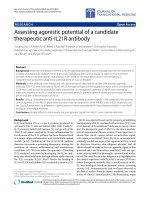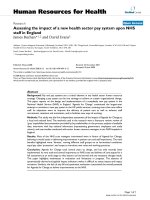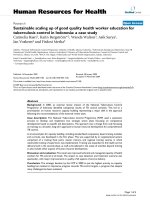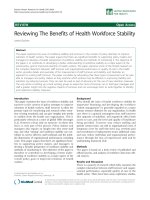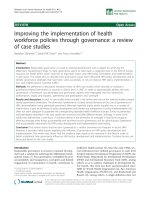báo cáo sinh học:" Assessing the impact of a new health sector pay system upon NHS staff in England" pot
Bạn đang xem bản rút gọn của tài liệu. Xem và tải ngay bản đầy đủ của tài liệu tại đây (227.32 KB, 7 trang )
BioMed Central
Page 1 of 7
(page number not for citation purposes)
Human Resources for Health
Open Access
Research
Assessing the impact of a new health sector pay system upon NHS
staff in England
James Buchan*
1,2
and David Evans
3
Address:
1
Queen Margaret University, Edinburgh, Scotland, EH21 6UU, UK,
2
Kings Fund, Cavendish Square, London, W1G 0AN, UK and
3
Capita
Health Services Partners, Harrogate, North Yorkshire, HG1 5PR, UK
Email: James Buchan* - ; David Evans -
* Corresponding author
Abstract
Background: Pay and pay systems are a critical element in any health sector human resource
strategy. Changing a pay system can be one strategy to achieve or sustain organizational change.
This paper reports on the design and implementation of a completely new pay system in the
National Health Service (NHS) in England. 'Agenda for Change' constituted the largest-ever
attempt to introduce a new pay system in the UK public services, covering more than one million
staff. Its objectives were to improve the delivery of patient care as well as enhance staff
recruitment, retention and motivation, and to facilitate new ways of working.
Methods: This study was the first independent assessment of the impact of Agenda for Change at
a local and national level. The methods used in the research were a literature review; review of
'grey' unpublished documentation provided by key stakeholders in the process; analysis of available
data; interviews with key national informants (representing government, employers and trade
unions), and case studies conducted with senior human resource managers in ten NHS hospitals in
England
Results: Most of the NHS trust managers interviewed were in favour of Agenda for Change,
believing it would assist in delivering improvements in patient care and staff experience. The main
benefits highlighted were: 'fairness', moving different staff groups on to harmonized conditions;
equal pay claim 'protection'; and scope to introduce new roles and working practices.
Conclusion: Agenda for Change took several years to design, and has only recently been
implemented. Its very scale and central importance to NHS costs and delivery of care argues for a
full assessment at an early stage so that lessons can be learned and any necessary changes made.
This paper highlights weaknesses in evaluation and limitations in progress. The absence of
systematically derived and applied impact indicators makes it difficult to assess impact and impact
variations. Similarly, the lack of any full and systematic evaluation constrained the overall potential
for Agenda for Change to deliver improvements to the NHS.
Published: 30 June 2008
Human Resources for Health 2008, 6:12 doi:10.1186/1478-4491-6-12
Received: 25 November 2007
Accepted: 30 June 2008
This article is available from: />© 2008 Buchan and Evans; licensee BioMed Central Ltd.
This is an Open Access article distributed under the terms of the Creative Commons Attribution License ( />),
which permits unrestricted use, distribution, and reproduction in any medium, provided the original work is properly cited.
Human Resources for Health 2008, 6:12 />Page 2 of 7
(page number not for citation purposes)
Background
Pay and pay systems are a critical element in any health
sector human resource strategy. Pay rates are a factor in
determining how the organization connects with external
labour markets, through staff recruitment and retention,
and the type of pay system selected by an organization can
be a major factor in creating organizational culture and
supporting specific types of staff behaviour and perform-
ance. Changing a pay system can be one strategy to
achieve or sustain organizational change. This paper,
commissioned by the Kings Fund, reports on the design
and implementation of a completely new pay system in
the National Health Service (NHS) in England.
In this paper progress in implementing "Agenda for
Change", the new pay system for NHS staff, is examined.
Agenda for Change constitutes the largest-ever attempt to
introduce a new pay system in the UK public services, cov-
ering more than one million staff. Its objectives were to
improve the delivery of patient care and support new ways
of working, as well as to enhance staff recruitment, reten-
tion and motivation.
The primary objectives of the research were firstly to
examine the impact of the new pay system at operational
level, through the case studies in the 10 trusts, where data
and information was sought on changes in costs, systems
and staff behaviour (e.g. turnover, absence rates); sec-
ondly to assess the national situation through analysis of
national level data and information on costs and impact;
and thirdly to assess the relevance and effectiveness of any
systematic evaluation of impact that was being conducted.
As such the study was intended to provide both local level
detail of the process of implementation, and national
level key findings [1]. The main audience for the research
was national level policy makers and local level manage-
ment.
The case for change in NHS pay
By the mid-1990s, the NHS pay system, developed nearly
50 years earlier with the creation of the NHS in 1948, was
increasingly being seen as outdated and not fit for pur-
pose. It was based on national bargaining units ("Whitley
councils"), each involving multiple staff associations/
trade unions representing different staff groups. The Whit-
ley system was regarded by many as complex and inflexi-
ble, constraining the development of new roles and
unresponsive to the high levels of contribution being
made by experienced clinical staff. It was also open to
challenge on the basis of equal pay for work of equal
value. Pressure to overhaul the pay system was growing as
the century ended.
With the election of a Labour government in May 1997,
the prospect of a new NHS pay system was raised. The new
government's White Paper on Health, published at the
end of 1997, announced the intention to 'modernise' the
NHS: 'In a national health service, the current mix of
national and local contracts is divisive and costly. The
Government's objective for the longer term was therefore
to see staff receive national pay, if this could be matched
by meaningful local flexibility, since the existing national
terms of service for a multitude of staff groups were
regarded as inequitable and inflexible [2].
In February 1999, the government published its proposals
for a new pay framework for NHS staff, "Agenda for
Change – Modernising the NHS Pay System" [3]. The pro-
posals included simplified national pay 'spines' covering
different staff groups, a national job evaluation scheme
and a competency-based career framework (later named
the Knowledge and Skills Framework (KSF)). The propos-
als emphasized that the new system was designed to:
• enable staff to give their best for patients, working in
new ways and breaking down traditional barriers;
• pay fairly and equitably for work done, with career pro-
gression based on responsibility, competence and satisfac-
tory performance;
• and simplify and "modernise conditions of service, with
national core conditions and considerable local flexibil-
ity.
Agenda for Change was just one element in the overall
approach to modernising the NHS and introducing a new
approach to workforce policy and planning. An NHS
human resources strategy for workforce expansion and
new ways of working was adopted [4], and a blueprint for
establishing a new approach to workforce planning and
development was agreed [5]. The new pay systems for
NHS staff were regarded as critical, integral elements in
this process of change.
The initial plan was to reach agreement with NHS staff
associations and trade unions on the new system by Sep-
tember 1999. This target date proved to be hopelessly
optimistic. In December 2002 an 'understanding' was
finally reached between the national negotiators from
management and unions and a framework document was
published. Negotiations continued and the proposed
agreement, including a three-year pay deal, was published
on 28 January 2003. Implementation began with a pilot-
ing process in 12 'early implementer' sites, followed by
the national roll-out of Agenda for Change from 1 Decem-
ber 2004. By the end of 2006, more than 99% of staff in
England was on Agenda for Change pay arrangements
(see Table 1).
Human Resources for Health 2008, 6:12 />Page 3 of 7
(page number not for citation purposes)
What is Agenda for Change?
Agenda for Change has been the largest and most ambi-
tious attempt ever to reform the NHS pay system. The new
pay system applies to more than 1 million NHS and it cov-
ers all staff groups apart from doctors and dentists, who
have separate new pay contracts, and very senior manag-
ers, who are mainly employed on individual contracts of
employment. Table 2 gives the key features of the new sys-
tem.
Agenda for Change introduced two new pay spines: one
for nurses and other health professionals; and one for
other directly employed NHS staff. These two pay spines
replaced the multiplicity of occupational pay grades, pay
points and salary scales that had characterized the Whitley
system.
To ensure that 'equal pay for work of equal value' was
delivered, the pay system was underpinned by a job eval-
uation scheme, which was based on 16 factors. Each factor
(e.g., 'analytical and judgement skills', 'emotional effort'
and 'working conditions') had different identified levels,
and a points score was derived for each job. The factors
and the weighting and scoring system used in Agenda for
Change were developed as a tailor-made system for NHS
staff as it was agreed there was no pre-existing system
capable of evaluating all of the jobs covered.
The new pay spines are divided into nine pay bands, and
staff covered by Agenda for Change were assimilated on to
one of these pay bands on the basis of job weight, as
measured by the NHS job evaluation scheme.
Agenda for Change also harmonized terms and condi-
tions of employment:
• Standard working hours for full-time staff of 37.5 hours
a week, excluding meal breaks, although protection and
assimilation arrangements mean that this will not be fully
achieved until December 2011.
• Single harmonized rate of time-and-a-half for all staff in
pay bands 1 to 7 eligible for overtime payments, and dou-
ble time for overtime on general public holidays.
• Annual leave entitlement (excluding 8 public holidays)
of 27 days on appointment, rising to 29 days after 5 years'
service and to 33 days after 10 years
See [1] for details.
A critical element in Agenda of Change is the Knowledge
and Skills Framework (KSF). This provides a framework
for the review and development of each staff member and
Table 1: The implementation timetable for Agenda for Change.
May 1997 Labour government elected
September 1997 Exploratory talks on a new NHS pay system begin
December 1997 White Paper on modernising the NHS is published
February 1999 Agenda for Change- Modernising the NHS Pay System is published
October 1999 First joint statement of progress
November 2000 Second joint statement of progress
November 2001 Third joint statement of progress
December 2002 Framework agreement agreed and published
January 2003 Proposed agreement and three-year pay deal announced
June 2003 'Early implementer' sites begin to implement Agenda for Change in England
December 2004 National roll-out of Agenda for Change starts in England
September 2005 Original deadline for assimilating staff on to new pay and conditions
October 2006 Original deadline for implementation of Knowledge and Skills Framework
February 2007 – April 2007 Consultation on draft proposals for unsocial hours payments
2007 Full implementation (other than ongoing consultation on new unsocial hours payments)
Source: Buchan and Evans 2007 [1]
Table 2: Key elements of Agenda for Change: pay bands (April
2006).
Pay band Job weight Pay range at 1 April 2006
1 0–160 £11 782 to £12 853
2 161–215 £12 177 to £15 107
3 216–270 £14 037 to £16 799
4 271–325 £16 405 to £19 730
5 326–395 £19 166 to £24 803
6 396–465 £22 886 to £31 004
7 466–539 £27 622 to £36 416
8a 540–584 £35 232 to £42 278
8b 585–629 £41 038 to £50 733
8c 630–674 £49 381 to £60 880
8d 675–720 £59 189 to £73 281
9 720–765 £69 899 to £88 397
Each pay band consists of a number of pay points, and staff progress
from point to point on an annual basis to the top point of their pay
range or pay band, provided their performance is satisfactory and
they can demonstrate the agreed knowledge and skills appropriate to
that part of the pay range or band.
There are special arrangements for new entrants to band 5 [1].
Human Resources for Health 2008, 6:12 />Page 4 of 7
(page number not for citation purposes)
is the basis for determining individual employee pay and
career progression within Agenda for Change. Each job
has a KSF post outline that sets out the dimensions, levels
and indicators required for the post-holder to undertake
their job effectively. The KSF process is based on an
annual developmental review between each staff member
and their line manager, which should produce a personal
development plan (PDP) (for details see [6]). The recent
Health Committee Report on NHS Workforce Planning
concluded that 'Effective use of the KSF has great potential
to improve staff productivity. The KSF can improve access
to relevant education and training, and support amended
roles which will allow staff to develop the skills required
to increase flexibility and efficiency" [7].
Methods
This study was the first independent assessment of the
impact of Agenda for Change at a local and national level.
The methods used in the research were a literature review;
review of 'grey' unpublished documentation provided by
key stakeholders in the process; analysis of available data;
interviews with key national informants (representing
government, employers and trade unions), and case stud-
ies conducted with senior human resource managers in
ten NHS hospitals in England [1].
The detailed case studies were conducted in NHS hospital
"trusts" in England from late March 2007 to May 2007
(see Table 3 for details). Interviews were conducted with
senior HR managers in each trust, using a standard inter-
view schedule. The schedule covered six areas: a review of
the implementation process so far in the trust; reported
experience so far in meeting five key improvement themes
related to Agenda for Change (benefits realization, finan-
cial management, strategic fit, redesign & modernisation,
value for money); specific detail on trust level work on
benefits realization; the local timeline to achieve full ben-
efits; the main indicators being used locally to evaluate
the impact of Agenda for Change; and future plans for
implementation/utilization of Agenda for Change.
Interviews were also conducted with key national inform-
ants who had been involved in the national negotiations
and/or have a current policy responsibility for NHS pay.
These interviewees came from both management and
union/professional associations, and in most cases they
were interviewed twice; once before the local case studies
had been conducted, and again afterwards.
Results
This section reports on the findings from the case study
hospital trusts in terms of the reported experience so far in
implementing Agenda for Change, and from feedback
from key national informants.
The rationale for Agenda for Change
Most of the NHS trust managers interviewed were in
favour of Agenda for Change, believing that, in part at
least, it would assist in delivering the improvements in
patient care and staff experience that were its stated objec-
tives. The main benefits of Agenda for Change highlighted
by these managers were: 'fairness', moving different staff
groups on to harmonized conditions; equal pay claim
'protection'; and scope to introduce new roles and work-
ing practices.
Costs
Implementing a new pay system inevitably incurs costs –
both one-off costs linked to the process of setting up new
systems, and ongoing costs if staff are assimilated on to
the new structure at a higher level. Given the need to
account for and control these costs and to check actual
costs against planned (and funded) pay changes, it is sur-
prising that not all the case study trusts could provide a
detailed assessment of local costs of implementation, and
those that did provided different types of costing. Three
trusts provided cost estimates of '3.6% ', 'about 2.5% to
3%', and 'between 4% and 6%' on the pay bill in the first
full year of implementation. The absence of a detailed
costing by all the trusts, and the absence of a consistent
approach to costing, provides one example of the relative
lack of detailed evaluation of impact of Agenda for
Change. Many managers also reported that the additional
funding provided had not been sufficient to cover the esti-
mated cost of implementation.
At national level the absence of any full evaluation of
implementation of Agenda for Change has limited an
assessment of its costs and benefits. Of the total 43 billion
UK sterling cash increase in NHS spending over the period
2002/3 to 2007/8 it has been estimated that 43% (18.9
billion UK sterling) has been absorbed in higher pay and
prices – mainly pay increases under Agenda for Change
and for medical staff. The implementation costs for the
new pay system have been calculated as a cumulative
additional cost of 2 200 million UK sterling in 2005/6 to
2008/9 [8].
Table 3: Case study NHS hospital trusts, March-May 2007.
Case study 1 teaching hospital in the South East
Case study 2: acute specialist trust in the North West
Case study 3 acute trust in the South East
Case study 4 acute trust in Yorkshire & Humberside
Case study 5 acute trust in the North West
Case study 6 acute hospital in the South East
Case study 7 acute teaching trust in London
Case study 8 teaching trust in London
Case study 9 acute trust in the South West
Case study 10 acute trust in the South West
Human Resources for Health 2008, 6:12 />Page 5 of 7
(page number not for citation purposes)
Implementation
Agenda for Change represents a new approach to pay
determination for NHS staff. One critical factor that
impacted during the latter stages of implementation was
that the financial situation facing the NHS was much
tighter than was the case when Agenda for Change was
being developed. The long delays in negotiation and
implementation meant that the new pay system was
beginning to function just as the NHS in England has
moved from a period of relative funding growth to one of
fiscal constraint, and where there has been greater scrutiny
on public sector pay awards [9-11].
The timing of implementation took longer than antici-
pated, and coverage was not complete at the time of the
case study research. At the time of the case studies, from
March to May 2007, none of the managers interviewed
reported that their organization had yet achieved 100 per
cent staff coverage of personal development plans (PDPs)
or had all their relevant staff assimilated on to the KSF.
They reported between 60% and 'nearly all' staff on PDPs;
and from 'not yet all' staff, up to '95%' and 'virtually all'
staff being on KSF job outlines. Managers in the case study
hospitals highlighted the fact that full benefits realization
is not achievable without a fully functioning KSF: 'We
need to maintain focus to fully embed KSF and maintain
the integrity of the system'; 'The key challenge now is get-
ting KSF sorted'.
These findings are supported by the results of a national
survey which quoted figures gathered by SHAs in Decem-
ber 2006 [12] suggesting that at that time only 67 per cent
of staff have a full KSF job outline.
Impact
Agenda for Change was intended to be a means to an end
– to facilitate the development of new roles and new ways
of working, and to improve staff recruitment and reten-
tion. This so-called 'benefits realization' was highlighted
as the rationale for investing in the new pay system.
The Department of Health in England published a draft
benefits realization framework in October 2004 to help
NHS organizations deliver the benefits expected of
Agenda for Change which made it clear that Agenda for
Change would be 'a contributory factor to achieving the
success criteria rather than the sole factor' [13]. The frame-
work included detailed suggestions on approaches to
measurement and data sources to be used. This was fol-
lowed by a schedule and timeline for benefits realization
[14] (see Table 4).
At the time of the research, Agenda for Change had been
implemented for about a year in the case study trusts. At
this relatively early stage in the process, most of the man-
agers interviewed could identify positive changes that had
already been achieved within their hospital as a result of
Agenda for Change. They all said their hospital trusts were
either in the implementation or intermediate phase of
benefits realization, as outlined in the benefits timeline.
Four main areas of 'implementation benefits' were identi-
fied by managers as having already been achieved in most
of the hospital trusts. These were: HR systems (e.g.
improved job descriptions), better partnership working
(e.g. more effective management-trade union relations),
equal pay and simplified human resources/payroll
administration.
The timeline for achieving benefits realization included
two long-term benefits: 'more patients treated more
quickly' and 'higher-quality care'. Managers in the case
study trusts indicated that they believed it would take
another two to five years to achieve these long-term bene-
fits. Even then, several cautioned that the broader impact
of financial deficits and tightening of NHS funding
streams, combined with the knock-on effects of increased
pay bill costs as Agenda for Change was implemented
fully, meant that full benefits realization would be chal-
lenging and problematic.
This was echoed at national level by some of the inter-
viewees, one union official commenting that: 'The jury is
out on benefits realization. There are good examples of
trusts using Agenda for Change to bring about improve-
ments in care, but the mainstream NHS has so far failed to
grasp the challenge Without further central government
pressure to deliver, opportunities will be lost.'
Table 4: NHS Employers benefits timeline for Agenda for Change.
Implementation benefits Intermediate benefits Long-term benefits
Fair pay More teamwork More patients treated
Better pay Greater innovation in staff deployment Higher-quality care
Partnership working Better career development
Equal opportunities and diversity Better recruitment and retention
Human resources systems Better morale
Simplified administration
(NHS Employers, 2005)[14]
Human Resources for Health 2008, 6:12 />Page 6 of 7
(page number not for citation purposes)
Some additional evidence of the impact of Agenda for
Change can be found in staff surveys. The October 2006
NHS staff survey conducted by the Healthcare Commis-
sion included, for the first time, some questions directly
concerning the implementation of Agenda for Change
[15].
Almost 69 500 staff from 171 NHS hospital trusts took
part in this survey. Nearly three quarters of staff in acute
trusts reported receiving a new job outline or job descrip-
tion and some 35% agreed or strongly agreed that they
were satisfied with the information they received from
their trust about Agenda for Change; 29% disagreed or
strongly disagreed (Table 5).
The annual survey of nurses conducted by the Royal Col-
lege of Nursing reported similar findings: many nurses
reported that they did not believe that the job evaluation
process had been carried out well at local level [16]. Many,
but not all of the nurses, believed they would be better
treated under Agenda for Change. In all, 44 % of nurses
reported that they thought they would be better off under
Agenda for Change, while 37% believed their circum-
stances would not change and 12% thought they would
be worse off.
Discussion
The key finding of the case study research at local level was
that, while interviewees could point to local examples of
benefits realization, there has so far been only limited
evaluation of the experience of implementation and of
the impact of Agenda for Change. The results of the case
study research highlighted variable local impact in the ten
case study NHS hospital trusts, variation in local assess-
ment of costs of implementation, and an absence of sys-
tematic national or regional level monitoring of impact.
Results of national staff surveys highlighted a mixed pic-
ture of impact, and suggested that implementation had
not been 'felt fair' by many staff. The results from 10 case
studies hospitals cannot be extrapolated to the whole of
an organization of several hundred hospitals. Despite the
huge overall costs, there has been no systematic assess-
ment of costs, benefits and impact. (The same criticism
has been made about the implementation of new pay
contracts for hospital consultants and for general practi-
tioners) [17,18].
Conclusion
The paper has set out an assessment of progress up to mid-
2007 with the implementation of the new pay system
within a national health system. Agenda for Change is the
largest-ever attempt to develop a new ('modern') pay sys-
tem in the public services in the United Kingdom. It
affects the livelihood of more than 1 million workers, has
a major impact on NHS finances, and by introducing links
to the knowledge and skills of the workforce, it also affects
patient care. The case study research reported in this paper
report was the first independent assessment of the imple-
mentation and impact of the new pay system, and high-
lights weaknesses in evaluation and limitations in
progress. The limited evidence made available in the case
studies and from staff surveys shows some positive
changes are occurring as a result of the new pay system,
but that the impact is variable between local level NHS
trusts. The absence of systematically derived and applied
impact indicators makes it difficult to assess impact and
variations in impact across the NHS.
While the pay system implemented in the NHS was
designed for the characteristics of that health care organi-
zation, there are some more general lessons for any coun-
try or health system considering a significant change in
their approach to pay determination. The time taken to
negotiate, design and implement the new pay system (sev-
eral years) reflects the complexities of the process, but also
the need to reconcile the changing and sometimes con-
flicting demands of various national stakeholders- gov-
ernment departments, trade unions, employers, etc. While
sufficient time must be built into such a process to accom-
modate these requirements, the longer the process, the
greater the danger that the organizational context and pri-
orities in which the pay system will function may have
changed. In the case of the NHS this was most notable in
relation to the changing funding situation across the time
period. Another key point is that achieving implementa-
tion of a new pay system ('ticking the box') should not be
regarded as the end of the process. It may take years before
a new pay system delivers on some of its stated objectives;
and if there is inadequate evaluation, this can hinder
Table 5: Responses of staff in acute trusts in relation to survey questions about Agenda for Change.
Agenda for Change Yes or agree/
strongly agree
No or disagree/
strongly disagree
Do not know
or neither
agree/disagree
Pay banding is fair 41% 35% 15%
Implemented successfully 25% 33% 36%
Has resulted in taking on increased responsibilities in job 21% 35% 32%
Source : The Healthcare Commission (2007) [15]
Publish with Bio Med Central and every
scientist can read your work free of charge
"BioMed Central will be the most significant development for
disseminating the results of biomedical research in our lifetime."
Sir Paul Nurse, Cancer Research UK
Your research papers will be:
available free of charge to the entire biomedical community
peer reviewed and published immediately upon acceptance
cited in PubMed and archived on PubMed Central
yours — you keep the copyright
Submit your manuscript here:
/>BioMedcentral
Human Resources for Health 2008, 6:12 />Page 7 of 7
(page number not for citation purposes)
assessment of progress made in delivery of these longer
term objectives.
It could be argued that it is "early days" for Agenda for
Change – it took several years to design, and has only
recently been implemented. But its very scale and central
importance to NHS costs and delivery of care argues for a
full assessment at an early stage so that lessons can be
learned and any necessary changes made. Given the scale
of the exercise, its costs and assumed benefits, the absence
of any full and systematic evaluation constrains the over-
all potential for Agenda for Change to deliver improve-
ments to the NHS.
Competing interests
The authors declare that they have no competing interests.
Authors' contributions
JB Directed the study, contributed to design, methods,
fieldwork and report writing, DE contributed to design,
methods, fieldwork and report writing.
Acknowledgements
The authors wish to acknowledge the support of the Kings Fund, in con-
ducting this study. The contribution of informants in NHS trusts and at
national level is also gratefully acknowledged.
References
1. Buchan J, Evans D: Realising the Benefits? Implementing Agenda for
Change Kings Fund, London; 2007.
2. Department of Health: The New NHS: Modern, dependable. Cm 3807
1997 [ />PublicationsPolicyAndGuidance/DH_4008869]. London: Department
of Health (accessed on 7 July 2007)
3. Department of Health: Agenda for Change – Modernising the NHS Pay
System. Health Service Circular HSC 1999/035 1999 [http://
www.dh.gov.uk/en/Publicationsandstatistics/Lettersandcirculars/
Healthservicecirculars/DH_4003632]. London: Department of Health
(accessed on 7 July 2007)
4. Department of Health: HR in the NHS Plan: More Staff Working Differ-
ently 2002 [ />tions/PublicationsPolicyAndGuidance/DH_4009112]. London:
Department of Health (accessed on 8 July 2007)
5. Department of Health: A Health Service of all the Talents: Developing the
NHS workforce – consultation document on the review of workforce plan-
ning [ />PublicationsPolicyAndGuidance/DH_4007967]. London: Department
of Health (accessed on 8 July 2007)
6. NHS Employers: The Knowledge and Skills Framework 2007 [http://
www.nhsemployers.org/pay-conditions/pay-conditions-782.cfm].
London: NHS Employers (accessed November 21 2007)
7. House of Commons Health Committee (2007): Workforce Planning:
Fourth report of session 2006–07. HC 171-I (2006–07) 2007 [http://
www.publications.parliament.uk/pa/cm/cmhealth.htm]. London: The
Stationery Office (accessed on 7 July 2007)
8. Wanless D, Appleby J, Harrison A, Patel D: Our Future Health Secured?
Kings Fund London; 2007.
9. House of Commons Health Committee: NHS Deficits: First report of
session 2006–07. HC 73-II 2006 [lia
ment.uk/pa/cm/cmhealth.htm]. London: The Stationery Office
(accessed on 7 July 2007)
10. Parish C: Public sector wages squeeze looks set to continue to
2010. Nursing Standard 2007, 21(47):6-7.
11. Incomes Data Services: Pay in the Public Services 2007 2007 [http://
www.incomesdata.co.uk/report/pps.htm]. Andover: Thomson, Sweet
and Maxwell (accessed on 8 July 2007)
12. O'Dowd A: 'Poor KSF progress puts careers at risk'. Nursing
Times 103(8):8-9. 20 February 2007
13. Department of Health: Agenda for Change – Review of experience in the
early implementer sites 2004 [ />sandstatistics/Publications/PublicationsPolicyAndGuidance/
DH_4091585]. London: Department of Health (accessed on 6 July
2007)
14. NHS Employers: Agenda for Change and Benefits Realization: A frame-
work for developing thinking 2005 [ />conditions/pay-conditions-783.cfm]. London: NHS Employers
(accessed on 7 July 2007)
15. Healthcare Commission: National survey of NHS staff' 2007
[http:www.healthcarecommission.org.uk/nationalfindings/surveys/
staffsur veys/2006nhsstaffsurvey.cfm]. London: Healthcare Commis-
sion (accessed on 6 July 2007)
16. Ball J, Pike J: Impact of Agenda for Change: Results from a survey of RCN
members working in the NHS/GP Practices Royal College of Nursing,
London; 2006.
17. National Audit Office: Pay Modernisation: A new contract for NHS con-
sultants in England 2007 [ />nao_reports/06-07/0607335.pdf]. NAO, London
18. Williams S, Buchan J: Assessing the New NHS Consultant Contract: A
Something for Something Deal? 2006 [ />lications/kings_fund_publications/assessing_the.html]. Kings Fund,
London

